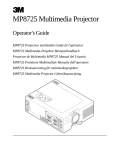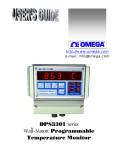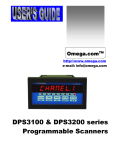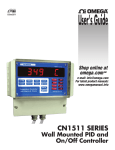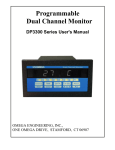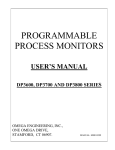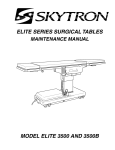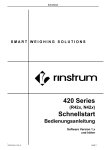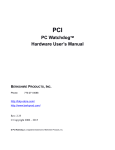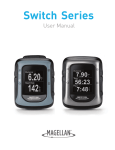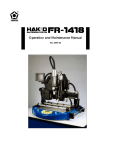Download Omega Vehicle Security DPS3300 User's Manual
Transcript
http://www.omega.com e-mail: [email protected] DPS3300 Series wall mount Multi-Channel Process Scanner TABLE OF CONTENTS SPECIFICATIONS ................................................................................................................................................................ 3 DESCRIPTION ...................................................................................................................................................................... 5 DISPLAYING PARAMETERS............................................................................................................................................. 6 Table 1. How to Display Parameters ................................................................................................................................. 6 DISPLAY MODES ............................................................................................................................................................ 7 Table 2. Display Modes..................................................................................................................................................... 7 Elapsed Time Mode............................................................................................................................................................ 7 Scan Mode.......................................................................................................................................................................... 8 High/Low Channel Mode ................................................................................................................................................... 8 Deviation Mode.................................................................................................................................................................. 9 Types of Deviation Displays .......................................................................................................................................... 9 Difference Mode................................................................................................................................................................. 9 SETUP.................................................................................................................................................................................... 9 'SYS' Parameter List......................................................................................................................................................... 10 CH Parameter List ............................................................................................................................................................ 10 CHANNEL CONFIGURATION ......................................................................................................................................... 11 Setup For Input Type.................................................................................................................................................... 11 Setup for Voltage or Current Input:.................................................................................................................................. 11 Setup For Channel ON/OFF ......................................................................................................................................... 11 Setup For Decimal Point Position ................................................................................................................................ 11 Setup For High Scale.................................................................................................................................................... 12 Setup For Low Scale .................................................................................................................................................... 12 Setup For Offset ........................................................................................................................................................... 12 Setup For Tare .............................................................................................................................................................. 12 Setup For Setpoint ........................................................................................................................................................ 13 Setup for Universal Relay (Channel 1 Relay) .............................................................................................................. 13 Setup For Limits ........................................................................................................................................................... 13 Setup For Deadband ..................................................................................................................................................... 13 Setup For Relay Normally Open/Closed ...................................................................................................................... 13 Setup For Engineering Units ........................................................................................................................................ 14 Setup for Thermocouple/ Thermistor/ RTD Inputs: ......................................................................................................... 14 Turning Channels ON/OFF: ......................................................................................................................................... 14 Temperature units:........................................................................................................................................................ 14 Setup Examples ................................................................................................................................................................ 15 Example #1: Use of the OFFSET Parameter ................................................................................................................ 15 Example #2: Use of the LOW SCALE Parameter........................................................................................................ 15 Example #3: Use of the TARE Parameter .................................................................................................................... 15 SYSTEM CONFIGURATION ............................................................................................................................................ 15 Setup For Display Options ............................................................................................................................................... 15 Table 3. Display Options............................................................................................................................................. 15 Setup For Display Time.................................................................................................................................................... 16 Setup For Relay Latch/Non-Latch.................................................................................................................................... 16 Relay Latched Mode: ................................................................................................................................................... 16 Relay Non-Latched Mode: ........................................................................................................................................... 16 Setup for Buzzer............................................................................................................................................................... 16 Setup For Cold Junction Calibration ................................................................................................................................ 16 Setup For Channel Calibration ......................................................................................................................................... 17 Input Range Setup (for current and voltage): ................................................................................................................... 17 Voltage Range Setup (0-10vdc, 0-5vdc) ...................................................................................................................... 17 Voltage Range Setup (for millivolt inputs) .................................................................................................................. 17 Current Range Setup..................................................................................................................................................... 17 Correct Range Settings ................................................................................................................................................. 17 Thermocouple Calibration Procedure............................................................................................................................... 17 SAVING PARAMETER:..................................................................................................................................................... 18 PEAKS ................................................................................................................................................................................. 18 PROGRAMMING FLOW CHARTS:.................................................................................................................................. 19 RATE ................................................................................................................................................................................... 22 LIMITS................................................................................................................................................................................. 22 OUTPUTS............................................................................................................................................................................ 22 Open Collector Option ..................................................................................................................................................... 22 Figure 1. Open Collector Hookup Example ................................................................................................................ 22 Page 1 TABLE OF CONTENTS Electro-Mechanical Relay Option .................................................................................................................................... 22 Figure 2. Electro-mechanical Relays Hookup Example ............................................................................................... 22 FIG- 3. DPS3300 Series terminal compartment .................................................................................................................. 23 POWER................................................................................................................................................................................ 24 INPUT CONNECTOR PIN ASSIGNMENT....................................................................................................................... 24 Table 4. DPS3300 Series Output Connector Pin Assignments......................................................................................... 24 DIRECT INTERFACE TO UNIVERSAL RELAY MODULE........................................................................................... 25 TROUBLE SHOOTING ...................................................................................................................................................... 26 Factory Channel settings: ................................................................................................................................................. 26 Factory default settings for Thermocouple, voltage, current and milli-volt are: .............................................................. 26 ERROR MESSAGES AND SOLUTIONS .......................................................................................................................... 26 MOUNTING ........................................................................................................................................................................ 27 Figure - 4. Rear View And Mounting Hole Locations .................................................................................................... 27 WARRANTY....................................................................................................................................................................... 28 Page 2 SPECIFICATIONS (Typical @ 25C and rated supply voltage unless otherwise specified) STANDARD INPUTS * 4-20ma 0-50ma 0-5Vdc 0-10Vdc * Thermocouple inputs: J, K, T, E, R, S, and B * Cold junction compensation error: +/- 1C (10C to 40C) * Open input indication: HELP displayed * Temperature displayable in Degrees C or F * Non-standard inputs available --- consult factory. ANALOG TO DIGITAL CONVERSION * 4-1/2 Digit (20,000) Count) A/D Converter * Dual slope integrating converter with 7 conversions /sec. (typical) rate. SCAN RATE * Fixed: two channels per second DISPLAY * Red seven segment displays--0.8" (20mm) digit height * Over range indication: HELP * Display test: Briefly displays 8.8.8.8.8.8.8 on power up. * Seven-digit display SCALE/OFFSET * Scale programmable from 1 - 30000 units * Offset programmable from 0 - 99.99mA (For mA Input) * Offset programmable from 0 - 9.999V (For Voltage Input) * Programmable decimal point. RELIABILITY/ACCURACY *Calibration: NIST traceable (for thermocouples) *Temperature resolution: 1C/1F * Warranty: 1 Year * Recalibration recommended at 12-month interval POWER REQUIREMENT * 120Vac --- 60 HZ * 240Vac --- 50 HZ * 15VDC (Standard) (optional) (optional) OUTPUT (optional) * Open collector outputs -- 50ma maximum sink, limited to 50ma per output * Relays: Single pole single throw, 1 Amp @ 28Vdc or 0.5 Amp @ 120Vac resistive *Output termination: Euro-style plug-in connector Page 3 NOTE DPS3304 & DPS3314 are four channel units. Therefore, any reference to channel numbers with respect to these models is for channels 1 through 4 only. DPS3307 and DPS3317 are seven channel units, and therefore, any reference to channel numbers for these models is for channels 1 through 7. DPS3304 & DPS3307 are base models that accept only one type of transducer signal on all four/seven inputs. DPS3314 & DPS3317 are enhanced models that have fully programmable inputs and each channel can be configured independently to accept a low voltage signal (T/C, RTD, Thermistor, milliVolt) or a voltage signal (0-5Vdc, 0-10Vdc) or a loop current signal (4-20mA, 0-50mA). Page 4 DESCRIPTION DPS3300 Series instruments are multi-channel scanners that pack a number of functions into one unit. Tasks that require multiple monitors can now be accomplished by using only a single unit. Signals from a number of different transducers can be brought into screw terminals that are conveniently located on the back panel of the instrument. The unit automatically scans through each channel, displaying the channel number and process value. In addition to displaying temperature, pressure, strain, etc. these units also boast some of the most frequently used functions such as process differential between channels, monitoring high and low readings on individual channels, rate of change, tracking channels with highest and lowest readings, comparison of process with a preset set-point, etc. Signals from thermocouples are linearized and can be displayed in degrees Celsius or Fahrenheit. Transducers that put out 4-20 ma. current loop, 0-5Vdc, or other linear signals can be scaled from the front keys. This gives the flexibility of displaying various parameters directly in engineering units. Channels that do not have signals connected to them may be programmed off by the operator and will not be scanned or displayed. On power up (check for proper power connections before powering up) the unit will first display 8.8.8.8.8.8.8. as a display test and then the software revision number. The format is 'rEn x.xx' where x.xx is the revision level. NOTE: Check model number for input type & display units -- thermocouples, 4-20ma, 0-10Vdc etc... MODEL NO. DPS3304 - (a) - (b) - (c) DPS3314 - (a) - (b) - (c) DPS3307 - (a) - (b) - (c) DPS3317 - (a) - (b) - (c) DESCRIPTION 4 Channel, fixed input scanner 4 Channel, programmable input scanner 7 Channel, fixed input scanner 7 Channel, programmable input scanner (a) INPUT TYPE (a) INPUT TYPE TC R S B RTD TH P J, K, T or E T /C ‘R’ thermocouple ‘S’ thermocouple ‘B’ thermocouple RTD (385, 392) Thermistor (400 Series) 100 millivolt C 4-20ma current (a) INPUT TYPE V 0-10 volt DC (b) POWER (c) OUTPUTS 5/3 6/4 Blank 4/7 Relay Outputs (optional) 4/7 Open Collector Outputs (optional) No Output (standard) Blank 1 2 120VAC Power Input (standard) 240VAC Power Input (optional) 15Vdc Power Input (optional) Page 5 DISPLAYING PARAMETERS DPS3300 Series keeps track of various parameters and these may be displayed by pushing appropriate keys on the front panel. The parameters that are tracked are: a) Channel's high peak b) Channel's low peak c) Elapsed time c) Channel with the highest reading d) e) f) g) Channel with the lowest reading Process deviation of each channel from pre-programmed setpoint Process differential of a channel with respect to any other channel Rate of process change per minute for each channel Table 1 explains how to display the above mentioned parameters. Table 1. How to Display Parameters TO DISPLAY PERFORM FOLLOWING STEPS 1) Channel's high peak a) Select channel whose high peak is desired (push CH SEL key) b) Push HI/LO key once 2) Channel's low peak a) Select channel whose low peak is desired (push CH SEL key) b) Push HI/LO key twice --- 1st push displays high peak, 2nd push , low peak. 3) Rate of process change a) Select channel whose Rate is desired (push CH SEL key) b) Push DATA key once. 4) Channel deviation a) Select desired channel (by pushing CH SEL key) b) Push DATA key twice --- 1st push displays rate, 2nd push, deviation. 5) Channel differentials a) Select desired channel (by pushing CH SEL key). b) Push DATA key three times -- 1st push displays rate, 2nd push: deviation, 3rd push : differential. c) Each additional push moves to the differential between selected channel and the next channel. d) e.g. the sequence for channel 1 is: RATE, CH1-SP, CH1-CH2, CH1-CH3, CH1-CH4, CH1-CH5, CH1-CH6, CH1-CH7 6) Elapsed time a) Push TIME key. 7) Channel with highest process reading a) Push HI/LO key once 8) Channel with lowest process reading a) Push HI/LO key twice ----1st push: 2nd push: 9) Scan a) If the unit is holding, push the SCN/HLD key once. 10)Hold a) If the unit is scanning, push the SCN/HLD key once. high channel low channel. Page 6 DISPLAY MODES DPS3300 Series has multiple display modes and can be programmed to either scan, display the channel with the highest reading, display the channel with the lowest reading, deviation between channel's process variable and a pre-programmed setpoint, difference between any two selected channels or just run as a timer. In the timer mode the unit keeps track of process run time with crystal controlled accuracy. Elapsed Time display format is 'HH.MM.SS' for hours, minutes, and seconds. The desired display mode is selected during SYS SETUP ---- (for details refer to the SYS CONFIGURATION section). Table 2. Display Modes MODE FUNCTION PERFORMED 1) Elapsed time Unit displays elapsed time since power up or last time reset. 2) Scan All active channels are automatically scanned. Channels that are turned off are not scanned or displayed. 3) High Channel The unit will compare all active channels against each other and display the one that has the highest process reading. 4) Low Channel The unit will compare all active channels against each other and display the one that has the lowest process reading. 5) Deviation The unit scans all active channels and displays the deviation of process variable from a pre-programmed setpoint. 6) Channel Differential The unit continuously displays the difference of process between any two selected channels. The following paragraphs give a detailed description and operation of various modes. Elapsed Time Mode DPS3300 Series can be programmed to run as timer. In this mode the unit will indicate elapsed time in hours, minutes and seconds. The display format is 'HH.MM.SS'. This mode is selected during SYS Setup by opting for 'ELPSD t'. The elapsed time is the time passed since the unit was turned on or when the time was last reset. To reset the time, first push the TIME key and while keeping it pressed, push the RESET key. The display will show 'rESEt' and on release of the RESET key, the display will reset to '00.00.00' and begin timing. The elapsed time can also be momentarily displayed while the unit is operating in any other display mode. This is done by pushing the TIME key once. The unit will first display the word 'ELPSd t' followed by the elapsed time. This will stay in the display window for a brief period and then the unit will revert to the normal display mode. Page 7 Scan Mode When setup for scan mode, individual channels are displayed for a programmed period of time. At the end of that time period the, display automatically switches to the next channel. For ease of reading, the display first shows the channel number (Format: 'CHANEL 1') and then the process variable along with the programmed three digit engineering units e.g. 23.45 PSI. Display time for each channel is programmable from 1-999 seconds (16.65 min.). This is useful for adjusting display time to a rate which is consistent with the type of process being monitored. Scan time for each channel is independent of display time. This permits programming long display times without losing track of the process on other channels. The display can also be put in a hold mode by pushing the SCN/HLD key. When this key is pushed, the display will briefly show 'HOLd' after which the display will stop on the channel it was indicating. Putting the unit in HOLD mode inhibits automatic display scanning and shows only one particular channel. While the display is held on one channel, internally all the enabled channels are continuously scanned for rate, difference, limits and other parameters. Also, during HOLD mode the unit will periodically flash the display 'Cx HOLd' ( x=channel # on hold) to indicate the status of the display mode. If an attempt is made to hold on a channel that has been turned off then the unit will indicate so by displaying in the format 'CHx OFF' ( x=channel # off). To select another channel for display during hold mode, push the CH. SEL key. Each push will increment the channel number. The display will first show the channel number (e.g. 'CHANEL 2' for channel # 2) followed by the process variable in the form '0.123 PSI'. When channel selection is initiated using the CH. SEL key, the unit starts with channel #1 and steps thru to channel #7 with each push of the key. To take the unit out of HOLD mode and back into SCAN mode, push the SCN/HLD key. The display will briefly show 'SCAN' and then start scanning the channels. High/Low Channel Mode DPS3300 Series compares all the channels against each other and constantly tracks the channel with the highest and lowest process value. On push of a key, the channel number and the value of process variable can be displayed. Also, during SYS Setup, the unit can be programmed so that instead of scanning all the channels it will only display the channel with highest or lowest process variable. As the process changes, the display automatically switches over to the channel with the highest (or lowest, if so programmed) reading. This is a very useful function for applications involving multi-point monitoring of temperature in a single process. For example, this feature can be used to find hot spots in a kiln. During high or low channel scan mode the display will periodically flash 'HI CHAN' or 'LO CHAN' (depending upon the selected mode) to indicate the status of the display mode. To display high and low channel from any other display mode simply push the HI/LO key. Pushing this key once will first display 'HI CHAN' and then the channel number and the process value will be displayed in the format 'C2 1234'. The second push on the HI/LO key will first show 'LO CHAN' in the display window, and then the channel with the lowest process value will be displayed. NOTE: (i) The second push, to display low channel, must be initiated before the display reverts back to the normal display mode. (ii) If a channel is selected using the CH. SEL key prior to the push on the HI/LO key, then instead of displaying high and low channels, the unit will display high and low peaks of the active channel. Therefore, if it is desired to display high and low channels and not the peaks, do not select a channel before pushing the HI/LO key. Page 8 Deviation Mode In deviation display mode, DPS3300 Series will show the differential between a pre-programmed setpoint and process variable being monitored on each channel by the scanner. Individual setpoint for each channel is programmed during CH Setup and can be any value over the range of selected scale or thermocouple being used. Types of Deviation Displays There are two different ways of displaying channel deviation from their setpoint values: a) The first one is a momentary display in which the deviation is indicated for a short time. Following this brief display time, the unit reverts to its normal mode of operation (scanning, differential, timer etc.). To achieve this, first select the channel whose setpoint deviation is desired. This is done by pushing the CH. SEL key. Next, push the DATA key twice. The first push displays the rate/minute value. The second push will display the deviation value. Before showing the deviation, the display will read 'CH1 - SP' ( for CHannel 1 SetPoint). b) The second method of displaying deviation is by selecting the 'dSP dEN' option when programming the Display Option during the SYS Setup. If this method is selected, the display will scan through all the active channels and display their deviation. The display format is 'd2 1234' (d stands for deviation). The unit can also be put on HOLD at any channel by pushing the SCN/HLD key. If any other channel's deviation is desired, it may be obtained by pushing the CH. SEL key. If an attempt is made to hold the display on a channel that has been turned off, then the unit indicates this by displaying 'CHx OFF' (x=channel #). DPS3300 Series will keep track of all other parameters while programmed for this mode (i.e. limits, peaks, rate, process value, channel differential etc). All of these may be displayed by pushing the respective keys. Difference Mode In this mode the system continuously displays the difference of process variable between any two selected channels. The two active channels are selected during SYS Setup mode. To remind the operator of the current display mode and also the two channels, the display flashes the channel numbers every few seconds (e.g. 'CH1 - CH2' for displaying difference between channel #1 and channel #2). If the unit is not programmed for difference mode, the differential between any two of the seven channels can be briefly displayed by pressing the DATA key. The procedure for doing so is to first select the channel whose differential with another channel is desired. This is done by pushing CH SEL key. Each push on this key will display the selected channel in the format 'CHANEL x'(x=channel #). When the desired channel has been selected, press the DATA key three times. The first push will display the rate of process change on that channel. The second push will show the process deviation from the programmed setpoint. The third push will flash a display of the form 'CH1 - CH2' and then a differential value. Additional pushes on DATA key will sequence thru the channels and will be indicated as below: CH1 - CH3, CH1 - CH4, CH1 - CH5, CH1 - CH6, CH1 - CH7, CH1 - SP SETUP Setup mode provides a means to customize the monitor to suit a particular application. It allows programming such parameters as temperature units, limits, display mode, relay deadband, etc. SETUP mode has 2 sections: a) SYS setup section to set system parameters b) CH setup section to set Channel parameters for each channel. Page 9 To get into SETUP mode, push the SETUP key twice. The first push displays elapsed time and the second push brings the unit into the SETUP mode. SETUP mode is indicated by 'SETUP' in the display window (the SETUP LED indicator will also be illuminated) followed by 'ENtR PC' (for ENteR PassCode). The passcode feature has been provided to keep unauthorized personnel from changing any parameters. Each of the five keys on the front panel are labeled with a number in the lower right corner. The pass-code is a four digit combination of these numbers. Enter the pass-code when the displays reads 'ENTR PC' . Passcode for DPS3300 Series is 3254. Once the correct pass-code has been entered, the display shows 'SYS CH', with 'CH' blinking. At this point the operator may choose between making channel settings (CH), or system settings (SYS). Use SDIGT key to toggle between CH and SYS modes. When the desired mode is blinking, press SETUP key to begin setup of parameters for that mode. 'SYS' Parameter List Following parameters can be setup when blinking 'SYS' is selected: 1) Display Options 3) Relay Latch/Non-latch a) Elapsed Time 4) Calibration/Range setting b) SCAN a) Cold Junction Reference Temperature c) High Channel b) Thermocouple/voltage/current calibration d) Low Channel c) Voltage Range e) Deviation d) Current Range f) Channel Difference 2) Display Elapsed Time For more details, refer to the SYSTEM CONFIGURATION section. CH Parameter List Following parameters can be setup when blinking 'CH' is selected: CURRENT OR VOLTAGE INPUT THERMOCOUPLE, RTD, THERMISTOR INPUT 1) Select Channel 2) Input Type 3) Channel ON/OFF 4) Decimal Point Position 5) High Scale 6) Low Scale 7) Offset 8) Tare 9) Setpoint 10) Limit 11) Deadband 12) Relay Normally Open/Closed 13) Display Units 1) Select Channel 2) Input type 3) Channel ON/OFF 4) Temperature units (C or F) 5) Setpoint 6) Limit 7) Deadband 8) Relay normally open/closed 9) Engineering units For more details, refer to the CHANNEL CONFIGURATION section. Three attempts at entering correct pass-code are allowed. 'HELP' shows up in the display window if attempted pass-code is wrong. If a person fails in three attempts, the system will go back to normal display mode. To make another attempt at this point one has to get into SETUP mode again. Three keys are used during setup --- SETUP, WDIGX and SDIGT. If, at any point during SETUP, it is desired to get out of SETUP and back to normal display mode, push and hold the RESET key until the display reads 'SAVING'. The SETUP key takes you from one parameter to the next e.g. if you are setting up Channel ON/OFF, then after getting the desired value push SETUP key to setup for Degrees C/F. WDIGX and SDIGT keys are used for programming values of parameters such as limits, setpoints, etc. Page 10 NOTE: To exit from any point during SETUP procedure or to save the newly made changes, simply press and hold the RESET key until the display shows 'SAVING'. When the display shows 'SAVING', it is indicating that the unchanged and the newly made changes are being saved in the EEPROM for permanent storage. It is important that the above step be performed any time changes are made to the configuration of the unit and before power is removed. If not done so, all the new changes will be lost. The unit will, however, maintain the old settings. CHANNEL CONFIGURATION After entering correct pass-code and selecting the blinking 'CH' (ref. SETUP section), the display shows 'SLCt CH' (for "Select Channel"). Use SDIGT key to display the desired channel. Selected channel will be displayed in the format 'CHANEL x' (where x=channel#). Once the desired channel # is displayed, push SETUP key to go on to setup parameters for the displayed channel #. Setup For Input Type The display will briefly show 'IP TYPE' (for "Input type") after which the present input type for the selected channel will be displayed. Various inputs available are: J T/C, CR.AL T/C (Chromel Alumel, type K T/C), T T/C, E T/C, CURRENT, or VOLTAGE. If the unit has a noble metal thermocouple option, then only one T/C can be selected i.e. B T/C, R T/C, or S T/C. Use the SDIGT key to display the desired input type. Once the desired input type is displayed, push the SETUP key to enter that input type and go to Setup For Channel ON/OFF. NOTE : If you have a millivolt input unit (instead of thermocouple), the various types of inputs selectable are CURRENT, HI VOLT and LO VOLT (for millivolt input). Setup for Voltage or Current Input: Setup For Channel ON/OFF After selecting input type, the next parameter for configuration is Channel ON/OFF, which determines whether a channel is scanned or not. If for any reason a channel is not being used, it must be turned OFF. In this way the unit will not spend any time scanning it. This will also prevent the unit from displaying a 'HELP' message on a channel that has nothing hooked up to it. Use SDIGT key to select the desired setting. If a channel is OFF, the display will show 'CHx OFF' , and if the channel is ON the display will show 'CHx ON' (x=channel #). Use SDIGT key to display the desired ON/OFF setting, and then push SETUP key to enter that setting and go on to setup Decimal Point Position. Setup For Decimal Point Position After turning a channel ON or OFF, the next parameter for configuration is setting the decimal point position. This is indicated by the display showing ' 9999' . SDIGT key moves the decimal point through all the possible positions. After '9.999', the display goes to '9999' which indicates a display with no decimal point. Use SDIGT key to move the decimal point to the desired position, and then push SETUP key to enter that setting and go to setup High Scale. Page 11 Setup For High Scale After setting a channel's decimal point position, the next parameter to be set is Hi Scale. This parameter determines what number will be displayed when the transducer puts out its maximum signal. For example, suppose a pressure transducer produces a 0Vdc to 10Vdc signal which corresponds to 0psi to 150psi. Then you would want the display to show 150 when 10Vdc is measured. To do this, set the Hi Scale=150. After pushing SETUP key, the display will briefly read 'HI SCLE' (for "High Scale"), and then show the current High Scale setting. The flashing digit is the active digit. Pushing SDIGT key and keeping it pushed, will increment the digit. Releasing SDIGT key and then pushing it again will decrement the value (SDIGT key works as a toggle -- alternating between increment and decrement). To change the next digit first push the WDIGX key. This will advance the flashing to the following digit. Use SDIGT key to change the value. After the desired High Scale setting is displayed, push SETUP key to enter that setting and go to setup Low Scale. Setup For Low Scale After setting a channel’s High Scale, the next parameter to be set is Low Scale. This parameter determines what number will be displayed when the transducer puts out its minimum signal. For example, suppose a pressure transducer produces a 0Vdc to 5Vdc signal which corresponds to 10psi to 75psi. In this case the display should read 10 when 0Vdc is measured. To do this, set the Lo Scale=10. On pushing SETUP key, the display will briefly read 'LO SCLE' (for "Low Scale"), and then show the present Low Scale setting. The flashing digit is the active digit. Use SDIGT key (as described in Setup For High Scale) to change the value. After the desired Low Scale setting is displayed, push SETUP key to enter that setting and go on to setup Offset. Setup For Offset After setting a channel’s Low Scale, the next parameter to be set is channel offset. Offset is used for calibrating a channel to a transducer that outputs a signal other than zero at its low end. If a transducer happens to output a small signal at its low end excitation, then the OFFSET parameter is used to make the transducer's minimum signal appear to be zero e.g. if a flow transducer outputs a 0.130Vdc to 5.000Vdc signal which corresponds to a flow RATE of 0 to 40 gal./min. Then to make the 0.130Vdc correspond to a display of 0, set OFFSET =0.130. NOTE: If the input type is CURRENT, the Offset value is entered in milliamps. If the input type is VOLTAGE, the Offset value is entered in volts. After pushing SETUP key at the completion of Setup For Low Scale, the display will briefly read 'OFFSEt', and then show the present Offset value. The active digit will be flashing. Use the SDIGT key (as described in Setup For High Scale) to enter a desired OFFSET value. After the desired OFFSET value is displayed, push SETUP key to go to Tare setup. Setup For Tare After setting a channel’s OFFSET, the next parameter to be set is channel's TARE. TARE is used if it is necessary to always subtract a value from a reading prior to displaying that reading. For example, suppose a pressure transducer always includes atmospheric pressure of 15 psi, and you only wish to display the pressure differential from atmospheric (a gage reading of 19psi is to be displayed as 4psi). To do this, enter the number you want subtracted from a measurement prior to displaying the measurement. The display will first show 'tARE' after which the current TARE value will be displayed. Use SDIGT key (ref. Setup Page 12 For High Scale) to set the desired TARE number. Once the desired TARE value is displayed, push SETUP key to enter that value and go to setup Setpoint. Setup For Setpoint After setting a channel's TARE, the next parameter to be set is channel's SETPOINT. SETPOINT is used in Deviation Display mode. In this mode the display is given as PROCESS-SETPOINT. For example, if it is desired to show how Channel #1 temperature readings are varying from a target temperature of 212 degrees, then make the SETPOINT for channel #1=212. When setting SETPOINT, the display will first show 'CHx SP', and then the current SETPOINT value. Use SDIGT key (ref. Setup For High Scale) to get the desired SETPOINT value. Once the desired SETPOINT value is displayed, push SETUP key to enter that value and go on to setup channel 1's operational mode. Setup for Universal Relay (Channel 1 Relay) Channel 1 relay can be configured to work as a universal relay or as Channel 1 relay only. In universal mode, this relay gets activated whenever any channel on the unit goes into alarm condition. In channel 1 mode, this output activates only if process reading on channel 1 exceeds channel 1's programmed limit value. Display format is 'C1 OnLY' (for 'Channel 1 only') or 'UnIVrSL' (for 'Universal'). Push SDIGT key to change to alternate mode and SETUP key after desired mode is achieved. Setup For Limits After setting a channel's SETPOINT, the next parameter to be set is LIMIT. DPS3300 Series uses the LIMIT parameter to determine when to activate output signal for a specific channel. When a reading exceeds the LIMIT for that channel, then that channel's output signal is activated. When the channel reading drops below the LIMIT setting by the amount of the DEADBAND setting, then the channel output is de-activated (if setup in non latching mode). The display will first show 'CHx Lt' (x=channel #) after which the current LIMIT value will be displayed. Use SDIGT key (ref. Setup For High Scale) to set the desired LIMIT value. Once the desired LIMIT value is displayed, push SETUP key to enter that value and go on to setup Deadband. Setup For Deadband After setting a channel's LIMIT, the next parameter to be set is channel's relay DEADBAND. This parameter is used for eliminating relay "chatter" as a signal hovers around its LIMIT value. When the channel reading drops below the LIMIT setting by an amount equal to the DEADBAND, then the channel output is deactivated. Minimum value of DEADBAND is 2. The display will first show 'dEAd bd' after which present DEADBAND value will be displayed. Use SDIGT key (ref. Setup For High Scale) to set the desired DEADBAND value. Once the desired DEADBAND value is displayed, push SETUP key to enter that value and go on to setup Relay as Normally Open/Closed. Setup For Relay Normally Open/Closed After setting DEADBAND, the next parameter determines whether the channel's output relay operates as a "Normally Open" or "Normally Closed" style relay. The relay itself is a Single Pole Single Throw (SPST) relay. Page 13 When this parameter is set for "Normally Open", the relay is open when it is deactivated (readings are below LIMIT), and closes when the channel reading exceeds its LIMIT value. When this parameter is set for "Normally Closed", the relay is closed when it is deactivated (readings are below LIMIT), and open when channel reading exceeds LIMIT value. The display will show 'rLy N.O.' for relay Normally Open or 'rLy N.C.' for Normally Closed setting. Use SDIGT key to toggle between the two settings. Once the desired setting is displayed, push SETUP key to enter that value and go on to setting up Engineering Units. Setup For Engineering Units After setting a channel's relay for NORMALLY OPEN/CLOSED operation, the next parameter to be set are the 3 letters that follow the process value in the display. These 3 letters represent the measurement units for that particular channel. Any desired combination of the following letters may be programmed: A,B,C,D,E,F,G,H,I,J,L,N,O,P,Q,R,S,T,U,Y The letter selection goes up to 'Y' and down to 'A' and from 'A' down to ' - ' sign. The ' -' sign indicates that the particular digit will be blanked e.g. if the desired engineering unit was feet, then the display can be programmed to show ' Ft'. In this case one digit will be blanked out by programming a ' - ' sign in its location. Three dots are displayed if no engineering units are programmed for a channel. Whenever the input type is changed from one type to another, the system automatically clears the engineering units. Therefore, it is necessary to re-enter new units after a change in the input type has been made. The only exception in this case is when a thermocouple selection is made. In that case, the unit automatically enters an 'F' or 'C' (Fahrenheit or Centigrade) depending upon the selected display units. However, just like the other inputs, any alternate units may be programmed for thermocouples. The display will first show 'Cx UNIt' (x=channel #) after which the current UNITS will be displayed. Use SDIGT key (ref. Setup For High Scale) to setup desired UNITS. Once the desired UNITS are displayed, push SETUP key to enter them and then go back to 'SYS CH' display. Setup for Thermocouple/ Thermistor/ RTD Inputs: Turning Channels ON/OFF: If selected option under 'IP tYPE' is thermocouple, RTD or thermistor, then the next step is turning the channel ON or OFF. This is done by pushing SDIGT key. Once the desired selection has been made, push SETUP key to go to the next step. Temperature units: This step configures the display units to Centigrade or Fahrenheit for the selected input. The display either shows "dEGrE C" or "dEGrE F" depending on previously selected units. Use SDIGT key to select alternate mode. Once having obtained the desired units, press SETUP key to go on to the next parameter. The following steps (i.e. channel setpoint, Channel limit, relay dead-band and engineering units) are the same as for voltage and current inputs -- refer to appropriate sections and/or flow chart. Page 14 Setup Examples Example #1: Use of the OFFSET Parameter Setup for a 4-20ma transducer signal corresponding to 0-500 gallons of fluid (reading in 10th of a gallon resolution): DECIMAL POINT HIGH SCALE LOW SCALE OFFSET TARE = 999.9 = 500.0 = 000.0 = 4.000 = 0.000 Example #2: Use of the LOW SCALE Parameter Setup for a 4-20ma transducer signal corresponding to 500-2000 degrees Fahrenheit temperature i.e. 500 degrees at 4ma and 2000 degrees at 20ma (one degree resolution): DECIMAL POINT HIGH SCALE LOW SCALE OFFSET TARE = 9999 = 2000 = 500 = 4.00 = 0.000 Example #3: Use of the TARE Parameter Setup for a 0-5Vdc transducer signal corresponding to 0-10.00 pounds of material being packaged in a box weighing 0.50 pounds with display reading in 0.01 lb. increments. DSP3200 should display the weight of the material only (not the box as well): DECIMAL POINT HIGH SCALE LOW SCALE OFFSET TARE = 99.99 = 10.00 = 00.00 = 0.00 = 0.50 SYSTEM CONFIGURATION After entering the correct pass-code and selecting the blinking 'SYS' (ref. SETUP section), DPS3300 Series goes into SYSTEM CONFIGURATION mode. This mode allows setting up parameters that affect all the channels or the instrument in general. Setup For Display Options After pushing SETUP key while SYS is blinking, the display briefly shows 'dSP OPt' (for display option) and then the present Display Option setting. Table 3 below lists all 6 display options available. Use SDIGT key to step thru the options. Once the desired Display Option is shown, push SETUP key to enter the setting and go to Setup For Display Time. Table 3. Display Options DISPLAY OPTION 1) Display elapsed time 2) Scan active channels 3) Display channel with highest reading 4) Display channel with lowest reading 5) Display deviation from SETPOINT 6) Display channel differential DISPLAY WINDOW READS ELPSEd t SCAn HI CHAN LO CHAN dSP dEN CH1 dIF Page 15 The channel numbers in Display Option #6 start with 'CH1 dIF' and go up to 'CH7 dIF' (CH4 dIF for 4 channel units). Following this the display jumps back to Option #1 (elapsed time), and the cycle is repeated. Setup For Display Time The next parameter to be set is DISPLAY TIME. This determines the number of seconds a channel's reading is displayed before moving to the next channel. The display will first show 'dSPLy t' (for Display Time), and then the current setting in seconds. Use SDIGT key (ref. Setup For High Scale) to set the desired DISPLAY TIME. Once the desired DISPLAY TIME value is displayed, push SETUP key to enter that value and go to setup Relay as Latching or NonLatching. Setup For Relay Latch/Non-Latch After setting DISPLAY TIME, the next parameter determines whether the output relays will operate in a Latched or NonLatched mode. Relay Latched Mode: In this mode the relay is activated when its LIMIT value is exceeded and stays activated until the operator manually resets the relay. To manually reset a channel relay, use CH. SEL key to step to the desired channel number, and while keeping the CH. SEL key pressed, simultaneously press the RESET key. Relay Non-Latched Mode: In this mode the relay is activated when its LIMIT value is exceeded. The relay is deactivated when the channel reading drops below the LIMIT value by the DEADBAND setting. The display will show 'NON LCH' for Non-Latch mode, or 'LAtCH' for Latch mode. Use SDIGT key to toggle between settings. Once the desired setting is displayed, push SETUP key to enter that value and go to Setup For Cold Junction Calibration. Setup for Buzzer The next step turns the buzzer on or off. Turning on the buzzer provides an audio alarm whenever any limit gets activated. Display format is 'ALr On' (for 'alarm on') or 'ALr OFF' (for 'alarm off'). Push SDIGT key to select desired mode. After completing the selection, push SETUP key to go to next step. Setup For Cold Junction Calibration After setting Relay Latch/Non-Latch, the next parameter is the cold junction reference temperature. The display will first show 'COLd JN' , and then the cold junction temperature will be indicated. Use the SDIGT key to adjust until the display reads the proper temperature. Once the correct temperature is displayed, push the SETUP key to enter that setting and go to Setup For Channel Calibration. NOTE 1: The unit must be powered up for at least ten minutes before adjustments are made to cold junction reading. NOTE 2: Press CH. SEL key to see the Cold Junction reading directly in millivolts. Page 16 Setup For Channel Calibration After setting the Cold Junction Reference temperature, the next step is a display of channels for calibration purposes. This allows easy calibration of each channel without the instrument scanning to the next channel. The display will show the channel input reading in the form 'x-nnnnn' where x=channel # and nnnnn is the channel reading. NOTE: ONLY channels that are turned ON will be displayed at this time! Press SETUP key to step the display to the next channel. Input Range Setup (for current and voltage): Voltage Range Setup (0-10vdc, 0-5vdc) After all the enabled channels have been displayed, the VOLTAGE range may be setup. The display will briefly show 'U rAnGE' (for "Voltage Range") followed by the current setting. Use SDIGT key (ref. Setup For High Scale) to set the desired VOLTAGE value. Once the desired value is displayed, push SETUP key to enter that value and go to the next step. Voltage Range Setup (for millivolt inputs) For Millivolt input units, the display first shows 'HV rnGE' (for "High Voltage Range"). After the High Voltage range is set, the display shows 'LV rnGE' (for "Low Voltage Range"). Enter values for respective inputs. Current Range Setup After VOLTAGE range has been set, the CURRENT range may be set. The display will briefly show 'C RANGE' (for "Current Range") followed by the current setting. Use SDIGT key (ref. Setup For High Scale) to set the desired CURRENT value. Once the correct CURRENT range is displayed, push SETUP key to enter that value and return to 'SYS CH' display. Correct Range Settings The following RANGE values should be entered for various inputs: RANGE VALUE INPUT 0-5 Vdc 5.000 0-10 Vdc 10.000 0-100 Mv 100.0 4-20 Ma. (loop current) 20.00 Thermocouple Calibration Procedure Note: Make sure the unit is reading correct cold-junction temperature before calibrating. If incorrect, adjust as described in the "Setup For Cold Junction" section. For a thermocouple channel calibration (type J T.C), following steps should be performed. Note that calibrating any channel automatically sets the calibration for all channels. Also, only one type of thermocouple input needs to be calibrated i.e. J,K,T or E. For example, if the calibration is done for a type K thermocouple, types J, T, and E are automatically calibrated. 1. Connect a thermocouple calibration source to channel 1. 2. Dial in 1100 degrees centigrade (Note: unit must be programmed for displaying in centigrade). Page 17 3. Adjust the gain pot of the instrument until the display reads '1100'. 4. Short channel #1's input with a wire or shorting bar. 5. Push DIFF key. The display will read '0002' --- or some other value. 6. Adjust offset pot of instrument until the display reads '0000'. 7. Push SETUP key -- the display will show Cold Junction temperature. 8. Remove the shorting bar from channel one input and connect the thermocouple calibrator again. 9. Repeat steps 2 through 7 till the unit reads proper temperature. 1 4 1: GAIN POT (T/C, MV, RTD, TH) 2: OFFSET POT 3: VOLTAGE POT 4: CURRENT POT SAVING PARAMETER: DPS3300 series saves all the programmed parameters in an EEPROM (electrically erasable programmable read only memory). An EEPROM stores the parameters even when power is removed from the unit. However, it is important to note that if the parameters are changed during setup, they must be saved in the EEPROM by pressing reset key as described under setup. If the parameters are not saved and the power is removed from the unit, any newly changed values will be lost (the unit will, however, maintain the old values). PEAKS A very useful function of DPS3300 is tracking the highest (peak) and the lowest (valley) point attained by each channel. This is particularly helpful if an operation is not being constantly watched or is left unattended (e.g. overnight). Since high and low points for each channel are monitored and stored separately, the history of changes at various points in the process can be obtained. This can be useful for quality control or for finding properties of a certain process. The first step in displaying peaks is to select the channel whose peaks are desired. This is done by pushing the 'CH. SEL' key. Each time this key is pushed, the display indicates the selected channel e.g. CHANEL 2, CHANEL 3 and so on. Page 18 Once the desired channel has been selected, push 'HI/LO' key. Pushing it once will show the high peak attained by the selected channel. Pushing it a second time will indicate the low process value (NOTE: The second push, to display valley, must be initiated before the display reverts to normal display mode). Before displaying high peak, the display will read 'CH2 HI' (for Channel 2 High Peak). Similarly, for low peak the display will indicate 'CH2 LO' (for Channel2 Low Peak) before showing the value. If an attempt is made to display the high or low peak of a channel which has been turned off (in CH Setup), the display will read 'CHx OFF' (x=channel #) to indicate the channel status. Peaks can be reset to the present value of process (e.g. if channel 1 is reading 200 C, its peaks can be reset to 200). This will allow tracking the process from present temperature being read by the unit. To reset high peak, first select the channel whose peak is desired to be reset (by pushing the CH. SEL key). Once the channel has been selected, push HI/LO key and keep it pushed. The display will read 'HI P' following which the value of high peak will be displayed. With HI/LO key still pushed, go on to push the RESET key. The display will read 'RESEt' and the unit will then take the present value of process on that channel and enter it as new high peak. To reset low peak, release HI/LO key (from high peak display mode) and push it again immediately -- and keep it pushed. The display will read 'LO P' and then the value of channel's low peak. With HI/LO key still pushed, press the RESET key. The display will read 'RESEt' and the unit will enter present process value as the channel's new low peak. PROGRAMMING FLOW CHARTS: FOLLOWING PAGES SHOW FLOW CHARTS FOR DPS3300 UNITS: Page 19 DPS3317 7 Channel Unit DPS3314 4 Channel Unit ENTER PASSCODE -- 3254 ‘SYS’ Flashing SYS CH ‘CH’ Flashing SELECT CHANNEL DISPLAY OPTION (Select one) ELAPSED TIME SCAN HIGH CHANNEL LOW CHANNEL DISPLAY DEVN. CHANNEL DIFF. -TH Option HI VOLTAGE CURRENT THERMISTOR DISPLAY TIME IP TYPE -BM Option R, S or B Option -100mv Option LO VOLTAGE HI VOLTAGE CURRENT -RTD Option HI VOLTAGE CURRENT RTD 385 RTD 392 VOLTAGE or CURRENT CHS. HI VOLTAGE CURRENT R, S or B T/C (only one T/C option) HI VOLTAGE CURRENT ‘J’ T/C CR.AL T/C (K) ‘T’ T/C ‘E’ T/C TEMPERATURE CHS. CH ON/OFF RELAY LATCH/NON-LATCH CH ON/OFF DECIMAL POINT AUDIO ALARM ON/OFF HIGH SCALE DEGREE C/F LOW SCALE COLD JUNCTION OFFSET CH. CALIBRATION TARE CH ‘X’ SETPOINT VOLTAGE RANGE CH1 RELAY/UNIVERSAL RELAY CURRENT RANGE ‘X’ stands for Channel No. CH ‘X’ LIMIT RELAY DEADBAND Back to ‘SYS CH’ RELAY NO/NC ENGINEERING UNIT Page 20 DPS3307 7 Channel Unit DPS3304 4 Channel Unit ENTER PASSCODE -- 3254 ‘SYS’ Flashing DISPLAY OPTION (Select one) ELAPSED TIME SCAN HIGH CHANNEL LOW CHANNEL DISPLAY DEVN. CHANNEL DIFF. -TH Option SYS CH ‘CH’ Flashing SELECT CHANNEL IP TYPE R, S or B Options mV, V or C Options ‘R’ T/C HI VOLTAGE THERMISTOR RTD 385 RTD 392 CURRENT DISPLAY TIME -BM Option -RTD Option LO VOLTAGE VOLTAGE or CURRENT CHS. ‘S’ T/C ‘B’ T/C ‘J’ T/C CR.AL T/C (K) ‘T’ T/C ‘E’ T/C TEMPERATURE CHS. CH ON/OFF RELAY LATCH/NON-LATCH CH ON/OFF DECIMAL POINT AUDIO ALARM ON/OFF HIGH SCALE DEGREE C/F LOW SCALE COLD JUNCTION OFFSET CH. CALIBRATION TARE CH ‘X’ SETPOINT VOLTAGE RANGE CH1 RELAY/UNIVERSAL RELAY CURRENT RANGE ‘X’ stands for Channel No. CH ‘X’ LIMIT RELAY DEADBAND Back to ‘SYS CH’ RELAY NO/NC ENGINEERING UNIT Page 21 RATE DPS3300 series tracks the rate of process change/minute for each channel. This rate is displayed by first pushing the CH. SEL key to select the channel whose rate is desired. Once the channel has been selected, push DATA key. The display will briefly read 'cx-rate' (x=channel #), and then the monitored rate for that channel. LIMITS DPS3300 series units support limit alarms on all the channels. These limits can be programmed over the entire range of selected thermocouple or scale. Thus, not only can these units be used as monitors but they can also provide control capability on each channel. Limit values are programmed during CH Setup. Also programmed during CH Setup is the dead-band (hysteresis) value. This keeps the relays from chattering when the process is hovering just around the limit. OUTPUTS DPS3300 Series units can be ordered with either open collector outputs or electro-mechanical relays. Check model number printed on the unit. Open Collector Option Whenever a limit is reached an open collector output provides a 5 Vdc signal at 50ma. on the output connector, eg.. Limit #4 provides its 5 volt output signal between pins 7 & 8 of the card edge. Figure 1. Open Collector Hookup Example Instrument +5VDC + OUTPUT 7 LOAD - OUTPUT 8 Solid Sate Relay LED, Buzzer, ETC. Electro-Mechanical Relay Option These relays are programmed during CH Setup to operate as either Normally Open (NO) or Normally Closed (NC). The default setting is Normally Open. Each of these limit relays provides a switched output whenever a limit is reached. The maximum rating for a 120Vac unit is 120Vac @ 0.5 amp or 28 Vdc @ 1.0 amp. A 240Vac unit is rated at 240Vac @ 0.25 amp. or 28Vdc @ 1.0 amp. Figure 2. Electro-mechanical Relays Hookup Example PLUG-IN CONNECTOR 8 Limit # 4 7 120 VAC @ 0.5 AMPS 5 120 VAC @ 0.5 AMPS 6 Limit # 3 Instrument Switched Outputs 4 Limit # 2 Limit # 1 3 120 VAC @ 0.5 AMPS 2 1 120 VAC @ 0.5 AMPS Page 22 NOTE: LOOK UNDER SPECIFICATIONS FOR THE RATING ON RELAYS AND OPEN COLLECTOR OUTPUTS. UNDER NO CONDITION SHOULD THE RELAYS AND OPEN COLLECTOR OUTPUTS BE OPERATED BEYOND THEIR RATED CAPACITY. DOING SO CAN DAMAGE THE UNIT PERMANENTLY. The status of the relays for all the channels is indicated on the front panel by a row of LEDs. Whenever the relay is energized, its respective LED is turned on. FIG- 3. DPS3300 Series TERMINAL COMPARTMENT OUTPUT CONNECTOR INPUT CONNECTOR L1 Pin 1 Pin 1 Pin 14 Pin 14 GND L2 POWER INPUT CONNECTOR Page 23 POWER Power connection should be made to the three terminal connector as shown in figure 3. Also, make note that it is very important that the power line inputs and the power ground are not switched. Doing so will permanently damage the instrument. Refer to Figure 3 for proper connections. For convenience, the printed circuit board is labeled L1 L2 GND on the under side of three terminal power connector. For instruments with the 15Vdc power option, L1 = negative supply and L2 = positive supply. NOTE: WHILE CONNECTING POWER TO THE UNIT, MAKE SURE THAT AC POWER LINE L1 OR L2 IS NOT ACCIDENTALLY CONNECTED TO GROUND (GND) TERMINAL. THIS WILL RESULT IN PERMANENT DAMAGE TO THE INSTRUMENT. DOUBLE CHECK THE CONNECTIONS BEFORE APPLYING POWER!! INPUT CONNECTOR PIN ASSIGNMENT 1 2 3 4 5 6 7 8 9 10 11 12 13 14 CH1 - CH1+ CH2 - CH2 + CH3 - CH3 + CH4 - CH4 + CH5 - CH5 + CH6 - CH6 + CH7 - CH7 + Table 4. DPS3300 Series Output Connector Pin Assignments OUT-PUT CONNECTOR PIN ASSIGNMENTS Pin # 1 2 3 4 5 6 7 8 9 10 11 12 13 14 Signal Channel #1 Limit Channel #1 Limit Channel #2 Limit Channel #2 Limit Channel #3 Limit Channel #3 Limit Channel #4 Limit Channel #4Limit Channel #5 Limit Channel #5 Limit Channel #6 Limit Channel #6 Limit Channel #7 Limit Channel #7 Limit Relay Output Common Normally Open/Closed* Common Normally Open /Closed* Common Normally Open/Closed* Common Normally Open/Closed* Common Normally Open/Closed* Common Normally Open/Closed* Common Normally Open/Closed* Open Collector Positive Output Negative Output Positive Output Negative Output Positive Output Negative Output Positive Output Negative Output Positive Output Negative Output Positive Output Negative Output Positive Output Negative Output * = Normally Open/Closed is user programmable (Look under Set-up) NOTE: PROPER RATING, CONNECTION AND CORRECT ORIENTATION OF THE CONNECTOR IS NECESSARY TO AVOID MALFUNCTION OR PERMANENT DAMAGE TO THE UNIT. Page 24 DIRECT INTERFACE TO UNIVERSAL RELAY MODULE A special feature in the DPS3300 series units allows direct interfacing with Universal Relay Module (Model RELAYURM400/800) – via a serial interface. The serial interface is available at a separate connector (as shown) in the terminal compartment. RELAY-URM400/800 series relay module is a very versatile instrument that is used for switching up to eight 15 ampere loads. In addition to the DPS3300 serial interface, RELAY-URM400/800 series relay module accepts low level input signals from PLCs, process controllers, indicators, motor starters, etc. Selectable input allows activation of output relays on direct acting or reverse acting signal. In addition to working with control/logic level signals, another very useful feature of RELAY-URM400/800 is activation of output relays on contact closure. The use of the RELAY-URM400/800 allows heavy loads requiring up to 15 amps to be controlled by the DPS3300 with minimal equipment & wiring. Input and output connections for the RELAY-URM400/800 are made through euro style pluggable connectors which are conveniently located on the top and bottom of the unit. Screw in terminals allow for quick connect/disconnect of wires. The unit is housed in a versatile enclosure that can be configured for mounting on a DIN rail or on a wall. If desired, the same enclosure can be panel mounted with relay, AC and DC supply status visible on the front. LEDs on the front panel turn on when a relay is energized. Two different versions are offered in this series. First one is RELAY-URM400 that has four relay outputs. The second one is RELAY-URM800 that has eight relay outputs. (Future versions will also include 415A solid state relays). Both units come with a built-in universal power supply. It operates from 100vac to 240vac. This power supply provides power not only to the internal electronics and relays but has up to 20watts (5, 12 or 24vdc) available for external applications by the user. DIRECT SERIAL INTERFACE TO RELAY-URM400/800 DPS3300 TERMINAL COMPARTMENT SERIAL PORT FOR RELAY-URM400/800 Page 25 TROUBLE SHOOTING If the meter locks on a particular display, unplug and plug in again to unlock the display. A total reset clears the memory and defaults all values to zero. To perform this reset, re-apply power with RESET key pressed in. Factory Channel settings: To obtain factory preset values simply re-apply power with SDIGT key pressed in. This will also clear memory of any erroneous values and is the preferred method of resetting a unit that might be malfunctioning due to corrupted memory . Factory default settings for Thermocouple, voltage, current and milli-volt are: PARAMETER HIGH SCALE LOW SCALE OFFSET TARE CURRENT INPUT 20.000 0.000 0.00 0.000 VOLTAGE. INPUT 10.000 0.000 0.00 0.000 MILLIVOLT INPUT T/C INPUT 100.00 0.000 0.00 0.000 J J J J ERROR MESSAGES AND SOLUTIONS ERROR MESSAGES AND SOLUTIONS ERROR MESSAGE ERROR CONDITION SOLUTION 'EE EROR' The unit was unable to save programmed value in EEPROM -- possible failure of EEPROM. If the message keeps coming up, unplug the unit and reapply power. If the unit still displays the error message, send it in for repair. If error message followed by 8.8.8.8.8.8.8.and the revision number are displayed occasionally, it is an indication that power line is very noisy and needs a line filter. 'CARD ER' Too much noise on input signals or problem with Scanner card. 1. If message shows occasionally, it indicates that input signal s have too much high voltage noise. Provide signal filters. 2. Unplug and plug the meter again to recycle power. 3. Scanner card defective -- send in for repair 'HIGH AC NOISE' High AC noise on input signals or incoming AC line interfering with the operation of the unit 1. If message shows occasionally, it indicates that input signals or AC line has too much high voltage noise. 2. Provide line and signal filters. Page 26 MOUNTING PICTURE HANGING-TYPE FIXTURE FOR MOUNTING SCREW 120mm 4.72” MOUNTING SCREW SLOTS 151mm 5.94” Figure - 4. Rear View And Mounting Hole Locations SLOTS IN TERMINAL COMPARTMENT FOR MOUNTING SCREWS Page 27 WARRANTY Page 28 Page 29 M4302/0306 Page 30































